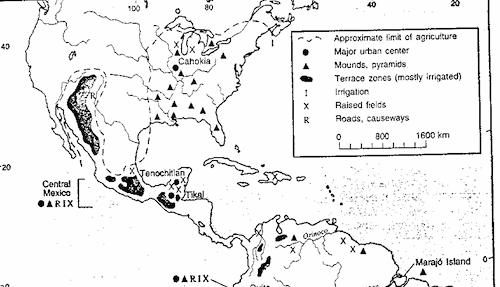The pristine myth the landscape of the americas in 1492

Introduction
In 1492, Christopher Columbus arrived in the Americas and his encounter with the indigenous people and the land forever changed the course of history. However, the narrative that the Americas were a pristine and untouched wilderness before the arrival of Europeans is a myth that has been perpetuated for centuries. This myth has been used to justify the exploitation and colonization of the Americas, and it is important to understand the true history of the land and its people.
What is the pristine myth?
The pristine myth, also known as the virgin land myth or the empty land myth, is the belief that the Americas were uninhabited and untouched by humans before the arrival of Europeans. This idea was first introduced by European explorers and settlers who saw the land as a blank slate for them to claim and develop.
This myth has been debunked by historians and archeologists who have found evidence of thriving indigenous cultures and civilizations across the Americas. These cultures had their own systems of agriculture, trade, and governance, and they had been living on the land for thousands of years before the arrival of Europeans.
The reality of the landscape in 1492
The Americas in 1492 were not a pristine wilderness, but rather a diverse and complex landscape shaped by thousands of years of human activity. The indigenous peoples of the Americas had developed sophisticated agricultural techniques that allowed them to cultivate a wide variety of crops, including maize, potatoes, and beans. They also had a deep understanding of the land and its resources, and they managed it sustainably for generations.
The landscape of the Americas was not just shaped by human activity, but also by natural forces such as wildfires, floods, and climate change. The indigenous peoples had adapted to these changes and had developed their own ways of mitigating their impact on the land.
The impact of European colonization
The arrival of Europeans in the Americas had a devastating impact on the land and its people. The Europeans brought with them diseases that the indigenous people had no immunity to, leading to widespread epidemics that decimated entire populations. The Europeans also brought with them a worldview that saw the land as a resource to be exploited for profit, leading to the destruction of the natural landscape and the displacement of indigenous peoples from their ancestral lands.
The Europeans also introduced new species of plants and animals that had a profound impact on the ecosystem of the Americas. These species often outcompeted native species and disrupted the delicate balance of the ecosystem, leading to further environmental degradation.
The legacy of the pristine myth
The pristine myth has had a lasting impact on the way we view the Americas and its indigenous peoples. It has been used to justify the exploitation and colonization of the land and its people, and it has perpetuated a narrative that erases the rich and complex history of the Americas before European arrival.
It is important to recognize the reality of the landscape in 1492 and to acknowledge the contributions of the indigenous peoples who have been living on the land for thousands of years. By doing so, we can begin to move towards a more just and sustainable future for all.
Conclusion
The pristine myth is a dangerous and false narrative that has been used to justify the exploitation and colonization of the Americas. It is important to recognize the reality of the landscape in 1492 and to acknowledge the rich and complex history of the indigenous peoples who have been living on the land for thousands of years. By doing so, we can begin to move towards a more just and sustainable future for all.
FAQs
1. Why was the pristine myth created?
The pristine myth was created by European explorers and settlers who saw the land as a blank slate for them to claim and develop. It was used to justify the exploitation and colonization of the Americas.
2. What evidence debunks the pristine myth?
Historians and archeologists have found evidence of thriving indigenous cultures and civilizations across the Americas, including sophisticated agricultural techniques and systems of governance.
3. How did European colonization impact the landscape of the Americas?
European colonization had a devastating impact on the land and its people, including the introduction of diseases, destruction of the natural landscape, and displacement of indigenous peoples from their ancestral lands.
4. What is the legacy of the pristine myth?
The legacy of the pristine myth is a narrative that erases the rich and complex history of the Americas before European arrival, and perpetuates a worldview that sees the land as a resource to be exploited for profit.
5. How can we move towards a more just and sustainable future?
By recognizing the reality of the landscape in 1492 and acknowledging the contributions of the indigenous peoples who have been living on the land for thousands of years, we can begin to move towards a more just and sustainable future for all.

Deja una respuesta